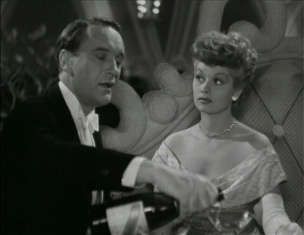No doubt you have often said “I’d love to watch a 1947 Douglas Sirk movie starring Lucille Ball and Boris Karloff that was a remake of a French film and was re-made again a half century later with Lucy’s part played by Al Pacino.” Okay, you’ve never said that, but nonetheless I gave you Lured.
The film tells the exciting story of the hunt for a serial killer who finds his young female victims though the newspaper’s “personal column” (This eventually became the title of the movie in the US after the Production Code censors ruled that “Lured” sounded too much like “Lurid”!). The fiendish villain taunts the police by sending them poems about his next intended victim. When another young woman is murdered, her plucky pal and fellow dance hall gal (Lucille Ball) feels it’s her duty to help a police inspector (Charles Coburn) catch the killer. Shadowed discreetly by a police minder (George Zucco), she starts answering ads in the personal column, which leads to dates which are by turns funny, disappointing and disturbing. Meanwhile she finds herself falling for a smooth-as-silk impresario (George Sanders) who with his business partner (Cedric Hardwicke) runs a chic club in which she hopes to audition as a dancer after the mystery is solved. But as she tries to decide whether to trust her beau enough to tell him of her work with the police, evidence emerges that he may somehow be connected to the case!
Many people only know Ball as Lucy Ricardo, but in fact she turned in some good performances in dark, dramatic films prior to ruling American television comedy for a quarter century. Lured and The Dark Corner are the best of her film noir work.
Ball had the fortune to launch her film career in a period when it was acceptable for female performers to be both funny and physically attractive. For most of the last half of 20th century, these attributes were often perceived as incompatible by entertainment moguls: Actresses were usually pigeon-holed as comic or sexy, but not both. My favorite example of this phenomenon was that Phyllis Diller was once going to do a Playboy spread as a joke, but when they took the photos it turned out that she looked beautiful under that house dress. The project was therefore shelved. Tina Fey and Amy Poehler are among the stars of today who have helped break down this constraint, restoring the possibility for other women to essay more multi-dimensional roles like Ball did in the late 1940s.
Ball is only one of the performers in Lured from whom Sirk got the very best. George Sanders played the sophisticated British rake in many movies and he does it yet again here. But so what? He’s very fun to watch doing what he does best. Coburn as the police inspector is appealing, particularly in his father-daughter style interactions with Ball. George Zucco, normally cast as a villain, shows a fine comic touch. Karloff is only on screen for one extended sequence, but nearly steals the movie as a deranged, grief-stricken has-been obsessed with the past. Last but not least, Hardwicke does well in perhaps the most complex part as Sanders’ business partner. The subtext of his emotions regarding Sanders and Ball is brought out subtly, in a way that clearly eluded the censors at the time. That is also a testament to Douglas Sirk, who loved to tell overtly conventional stories with implicit, then unacceptable, undertones that only some of the audience appreciated.
Lured is also a fine-looking picture, as you would expect when the camera in the hands of William H. Daniels. Sirk clearly influenced at least some of the shot framings, as they strongly prefigure the scene compositions he would employ in his 1950s heyday.
Lured does have some problems with tone and pace. It’s effort to mix comic, suspenseful and disturbing elements simply doesn’t always work. There are also some draggy moments that should have been left on the cutting room floor. One has to ask as well why the movie is set in London when it clearly was not shot there and Coburn’s police inspector sounds thoroughly American. Collectively, these flaws keep Lured in the good rather than great category.
If the story of Lured appeals to you, you might enjoy the other two above-average efforts to adapt it to the screen: The 1939 French movie Pieges directed by Robert Siodmak, and the 1989 U.S. film Sea of Love with Al Pacino and Ellen Barkin.
p.s. Look fast for Gerald Hamer in an uncredited small role in the dance hall early in the film. He was an essential part of another of my recommendations: The Scarlet Claw.


